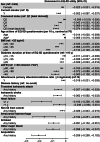Decrements in health-related quality of life associated with adverse events in people with diabetes
- PMID: 34866309
- PMCID: PMC9361007
- DOI: 10.1111/dom.14610
Decrements in health-related quality of life associated with adverse events in people with diabetes
Abstract
Aim: To estimate the decrements in health-related quality of life (QoL) associated with a range of adverse events to inform assessments of the effects of diabetes treatments on QoL in contemporary clinical practice.
Methods: Participants' QoL utility measures were derived from the five-level EuroQoL five-dimensional (EQ-5D-5L) questionnaires completed by 11 683 ASCEND participants (76% of 15 480 recruited). EQ-5D utility decrements associated with cardiovascular (myocardial infarction, coronary revascularization, transient ischaemic attack [TIA], ischaemic stroke, heart failure), bleeding (gastrointestinal [GI] bleed, intracranial haemorrhage, other major bleed), cancer (GI tract cancer, non-GI tract cancer), and microvascular events (end-stage renal disease [ESRD], amputation) were estimated using a linear regression model following adjustment for participants' sociodemographic and clinical risk factors.
Results: Amputation was associated with the largest EQ-5D utility decrement (-0.206), followed by heart failure (-0.185), intracranial haemorrhage (-0.164), GI bleed (-0.091), other major bleed (-0.096), ischaemic stroke (-0.061), TIA (-0.057), and non-GI tract cancer (-0.026). We were unable to detect decrements in EQ-5D utility associated with myocardial infarction, coronary revascularization, GI tract cancer, or ESRD. EQ-5D utility was lower at older age, independent of other factors.
Conclusion: These estimated decrements in QoL associated with cardiovascular, bleeding, cancer, and other adverse events can inform assessments of the overall value of treatments in patients with diabetes.
Keywords: cardiovascular disease; diabetes complications; health economics.
© 2021 The Authors. Diabetes, Obesity and Metabolism published by John Wiley & Sons Ltd.
Conflict of interest statement
All authors declare no conflict of interest.
Figures


References
-
- Gregg EW, Sattar N, Ali MK. The changing face of diabetes complications. Lancet Diabetes Endocrinol. 2016;4(6):537‐547. - PubMed
-
- Schmittdiel J, Vijan S, Fireman B, Lafata JE, Oestreicher N, Selby JV. Predicted quality‐adjusted life years as a composite measure of the clinical value of diabetes risk factor control. Med Care. 2007;45(4):315‐321. - PubMed
Publication types
MeSH terms
Grants and funding
LinkOut - more resources
Full Text Sources
Medical

